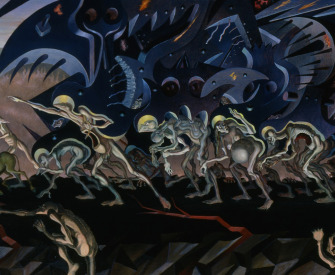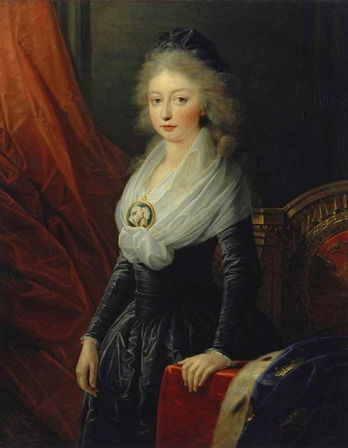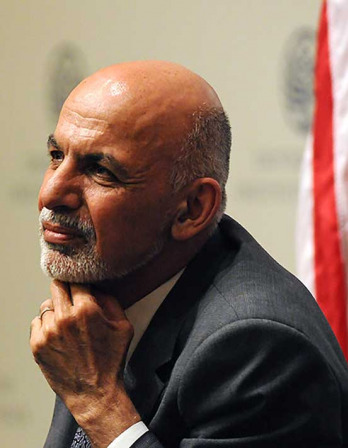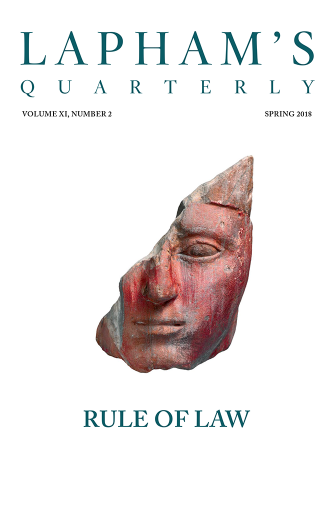I never practice, I always play.
—Wanda Landowska, 1953Songs from Sinjar
How ISIS is hastening the end of the Yezidis’ ancient oral tradition.
By Alex Cuadros

Illustration of a Yezidi man approaching a temple, from A Journey from London to Persepolis, c. 1865.
Audio brought to you by Curio, a Lapham’s Quarterly partner
There is a Yezidi hymn about a man whose tongue was cut off by the sultan of Mosul. For three days and three nights, he could not even lament. So he went to the valley of Lalish, to the holy community led by Sheikh Adi—the only perfect being other than God. “Sheikh Adi blew on his mouth / four times,” and the man’s tongue grew back better than before.
Some nine hundred years ago, before Sheikh Adi settled in Lalish, he is said to have stopped at a spring in the Sinjar Mountains, eighty miles west, near what is now the border with Syria. I could hear the spring’s trickle when my pickup’s engine shut off. It was at the end of a rutted track off a narrow asphalt road, past hundreds of white poly-cotton tents branded UNHCR and UNICEF. A shrine was built there, a conical spire rising from a slash of green in the dry scree. My interpreter called out for the caretaker, and from an adjoining compound a man emerged whose beard reached almost to his eyes. He was a feqir, literally “poor man”—a Yezidi ascetic. Introducing himself as Khalid Barakat, he led us to a patio and pulled out mats for us to sit on. One of his sons served fresh goat yogurt and sugar-rich tea.
Khalid agreed to talk about August 2014, when the black flags came. Suddenly the valley filled with Yezidis fleeing their villages in the surrounding plains. ISIS had rounded up and murdered a thousand Yezidis in the space of a few days. Thousands of women and children had been abducted. Khalid sheltered as many people as he could, American planes dropped water and food, but it was not enough. Sinjar in summer is sun scorched. Desperate young men snuck into the nearby town of Snuny to raid abandoned shops for supplies; some were shot. The siege lasted a week, until the American air strikes began, and Kurdish fighters helped the stranded Yezidis get to Syria.

Women playing music, Chinese hanging scroll, seventeenth to early twentieth century. © Philadelphia Museum of Art, purchased with funds contributed by Edward B. Robinette from the Simkhovitch Collection, 1929.
ISIS tried to wipe out the Yezidis because it believes them to be infidels. According to the rules of the caliphate, even Jews earn protections as a People of the Book, but the Yezidis have no book. Instead they have memorizers like Khalid who have passed down the religion by singing hymns and telling stories. This has brought endless trouble, for in the absence of a scripture, outsiders smeared the Yezidis as devil worshippers. Wherever ISIS soldiers found the cone of a Yezidi shrine, they blew it up.
Of the half a million Yezidis in the world, more than 300,000 used to live in Sinjar. The vast majority ended up in temporary camps by the highways of northern Iraq if they did not flee the country altogether. Some carried pieces of unwritten scripture in their heads, unrecorded melodies, subtleties of rhythm and tone that defy annotation. I asked if what they knew could be lost. “Of course, we’re afraid of this,” Khalid said. “Already some traditions have been forgotten. But we’re also afraid of losing our children.” At the time, March 2017, the front line with ISIS was just a few miles south of Sinjar. In April, Turkish planes would drop bombs on positions held by a Yezidi-Kurdish militia in the mountains. One of Khalid’s sons had already made it to Germany and requested asylum for the rest of the family. “If we get the chance,” Khalid said, “we’re going to leave the country.”
Music is vital to the Yezidi religion. According to the hymns, the first soul refused to enter Adam without the accompaniment of flute and tambourine, the sacred instruments. The sacred instruments are played by qewwals, “professionals of the word,” whose duty it is to take the seven holy peacock standards—bronze icons of Tawusi Melek, the Peacock Angel—to the far corners of Yezidism. For lay Yezidis, the Parading of the Peacock provides one of few chances to hear their hymns. But the standards do not circulate in times of war. ISIS laid waste to the qewwals’ tribal home, Bashiqa and Bahzani, twin towns just east of Mosul.
A Hungarian scholar named Eszter Spät estimated that just a dozen qewwals remained even before the attacks of 2014. A documentary she made about one of their tours through Sinjar shows ceremonies held in the guest room of a village notable as the assembled men chain-smoked hand-rolled cigarettes of tobacco grown there in the mountains. Sitting cross-legged on a mat, one qewwal would give a sermon. Then his tambourine came out—large enough to obscure his whole torso, its skin age-stained, played to a beat that constantly shifted, slowing down and speeding up again. Another qewwal played the flute—high-pitched, frenetically trilling, only vaguely melodious. Now and then the tambourine gave way to hymns whose notes were precise but discordant, closer to incantation than song.
The Yezidis kept their hymns secret for centuries, so scholars have barely analyzed them as music. The first major English-language study appeared only in 1995, when a Dutch scholar named Philip Kreyenbroek translated nineteen of an untold number of hymns. In Kurmanji, the dialect spoken by most Yezidis and northern Kurds, the holiest of hymns is a qewl. The form is often cryptic: “Four lamps with one wick! / There are seven doorways for one Word. / Eleven are a deep ditch: / Seven are dark, four are luminous.” Qewls can also bend familiar words into new shapes for rhyme and rhythm; despite the help of Yezidi intellectuals, Kreyenbroek’s translations are pocked with ellipses where even the literal meaning is unclear. Some verses seem to chastise those who yearn to grasp them: “My poor one of little patience… / We shall give descriptions of the deep oceans.” I met one young Yezidi who said he understood next to nothing in the qewls but liked the sound.
No one knows for sure why the qewls are sung and not just spoken. With few exceptions, no one knows who composed them, either—beyond God, who is thought to have revealed them at some point in the distant past. A memorizer, though, knows who taught him every piece in his repertoire. Each hymn is the product of a unique line of transmission, so the stanzas vary from region to region, generation to generation, person to person. Qewwals are not the only ones who recite hymns; there are also feqirs and ulmdars as well as two priestly castes, sheikh and pir, that administer rites for birth, death, and marriage—all generically known as qewlbejs, or “tellers of hymns.” One qewl, sung in Yezidi communities as far-flung as Germany and the Caucasus, has thirty known variations. It could be no other way in a game of telephone that has lasted centuries.
Hymns, too, are only part of the story. A talented memorizer will intersperse sung stanzas with sections from prose narratives known as chiroks. Some chiroks serve mainly to illuminate the most enigmatic verses of a qewl, while others recount myths that are not in the hymns at all. They are just as important to the religion but even more flexible, with much room for individual flourishes and interpretations. Different versions can even contradict each other.
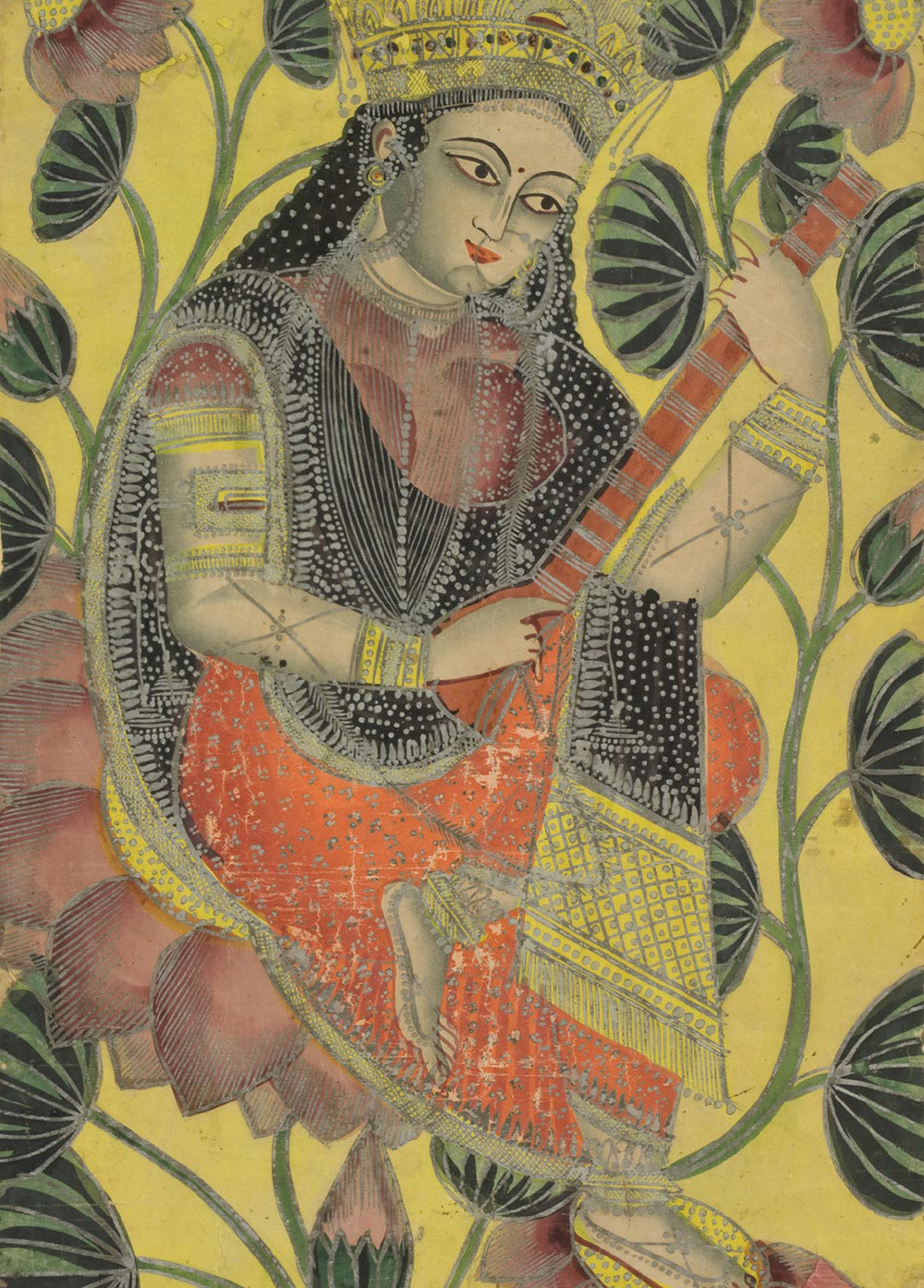
Hindu goddess of knowledge and music Sarasvati playing a type of vina named after her, India, c. 1850–75. © Philadelphia Museum of Art, Stella Kramrisch Collection, 1994.
Yezidism is by nature fragmented, multiform, always gradually rewriting itself, adapting to new pressures. Even its most powerful taboos are not set in stone. After 2014 the clerical council bent the old ordinance that sex with a non-Yezidi brings excommunication, so that any girl who was enslaved by ISIS could rejoin the community. She must only be rebaptized at the holy spring at Lalish.
The Yezidis have long cherished their separateness. According to their religion, they did not come from Adam and Eve. God told Tawusi Melek to lure Adam out of Paradise so humankind could commence, and so the Peacock Angel tossed a grain of wheat into Adam’s mouth, causing his belly to swell. In one version of the story, his body had no outlet, so Tawusi Melek pecked an anus into his backside. But Adam could not sully the Garden of Eden, so Tawusi Melek led him out to relieve himself. Adam cursed Tawusi Melek for his trickery, calling him a name that Yezidis are forbidden to repeat. Tawusi Melek in turn took Adam’s divine essence and put it in a jar. From it was born a boy—Shehid ben Jar, the Witness of the Jar—who married Leyla, a houri from paradise. Their descendants are the Yezidis, who never cursed Tawusi Melek.
Many qewls tell of the beginning of time, when God created a pearl from which many colors burst forth and holy leaven made oceans coagulate into earth. Others tell of the time of Sheikh Adi, revered by Yezidis as the reformer of what they say is the world’s oldest religion. Very little is known about the origins of Yezidism, but scholars believe Sheikh Adi was a Sufi who founded a religious order in the valley of Lalish, near Mosul, around 1100. There, on the shifting borders of a series of empires, his mystical school of Islam mingled with the pre-Zoroastrian beliefs of western Iranians, Judeo-Christian and Gnostic traditions, and even Greek myths. One Yezidi story tells of Nemrud, who is put in a box as a baby and tossed out to sea—like Moses. Later Nemrud kills his father and unwittingly marries his mother—like Oedipus. This stew of faiths spread west to Aleppo, east into Persia, and north into what is now Turkey.
The historical Sheikh Adi was unmistakably Muslim, but in the oral tradition, he embodies Yezidism in its mature, syncretic form. He is timeless, godly. When the sultan of Mosul sends a mule carrying two skins of poison to Lalish, Sheikh Adi declares, “On one side there is oil, on the other honey!” And it is so.
Persecution by Islamic rulers is a constant in Yezidi songs and stories. The United Nations uses the word genocide to describe what ISIS has done to the Yezidis, but the Yezidis call it a ferman. Of the seventy-four fermans they speak of, perhaps the earliest came in 1254, when the governor of Mosul sent his troops to Lalish, killed two hundred of Sheikh Adi’s disciples, and had the great reformer’s bones dug up and burned. Long before ISIS, the Ottomans launched campaigns of forced conversion and sold Yezidi women and children into slavery. In one assault on Sinjar, an Ottoman general massacred several hundred Yezidis, then had their ears cut off and hung at the gates of Mosul.
The Ottomans had their reasons for hating these people. The Yezidi tribes of Sinjar were known for robbing the caravans that passed between Mosul and Aleppo. They also balked at Ottoman taxes and conscription. Allegations of devil worship trace to the seventeenth century, when travelers reported that Yezidis would kill anyone who cursed Satan. Then there was the Peacock Angel: in some Islamic stories it was Satan’s peacock who lured Adam and Eve out of Paradise. In reality, Yezidis tend to associate Tawusi Melek not with any fallen angel but with the archangel Gabriel. Satan, they believe, is the name Adam used to curse Tawusi Melek, making it taboo to utter at all. But Yezidis were reluctant to share their traditions with outsiders, and the dark rumors grew. Even today many Muslims refuse to eat their food.
Westerners helped spread the slander. In a typical dispatch from 1928, Ralph Horatio Woolnough Empson, a British military officer, declared that “the propitiation of the devil is almost continually in the minds of the Yezidis.” At least he admitted that his sources included “local gossip.” In 1852 a missionary named George Percy Badger declared that “great lewdness secretly prevails” among the Yezidis. They were “a very industrious race,” Badger conceded, “clean in their habits” but also “intemperate in the use of arrack.” Their taboos—against lettuce and the color blue, for example—made them easy objects of ridicule. When the Journal Asiatique published some Yezidi myths, its editorial board in Paris, in classic orientalist fashion, labeled them “puerile.” In the religion’s uncharted past, many scholars found an open stage for their erudition, and it became a fad to speculate on its origins among the Chaldeans or the Sabaeans or the ancient magi of Persia.
Without music life would be a mistake.
—Friedrich Nietzsche, 1889Part of the problem in pinning down the details was that Yezidis themselves often did not know the answers. For most of their history, writing was forbidden to all but one family of the sheikh caste, possibly to avoid indoctrination in Islamic schools. Most laypeople received formal religious instruction only at festivals at Lalish or when traveling qewwals came to their villages. There was no weekly mass. Prayer was any private appeal made while facing the sun or a sack of soil from Lalish, hung on a wall at home.
Some Yezidi misdirection may have been tactical, a way to shield their secrets—or, in a land where only People of the Book were truly considered people, to protect themselves. It took a diplomatic intervention from the British to persuade the Ottomans to stop taking Yezidi children as slaves. This may explain why Yezidi holy men occasionally claimed they did, in fact, possess a scripture. “They have a sacred volume, containing their traditions, their hymns, directions for the performance of their rites, and other matters connected with their religion,” one Sir Austen Henry Layard wrote in 1849. “It is preserved either at Baazini or Baasheikhah”—those twin Yezidi towns near Mosul—“and is regarded with so much superstitious reverence that I failed in every endeavor to obtain a copy or even to see it.”
Still, the legend persisted. Later travelers heard of two sacred volumes: the Jelwa, the Book of Splendor, and the Meshaf Resh, the Black Book. And then at the end of the nineteenth century, they surfaced—multiple copies of them, with curious synchronicity and colorful backstories. Jeremiah Shamir, an Arab Christian monk and manuscript dealer, claimed he had gotten the Baba Sheikh—the Yezidis’ highest spiritual authority—drunk, persuaded him to bring out the Jelwa, and copied its pages. Another man of religion, a Carmelite priest named Anastase Marie de Saint-Élie, said he had purchased his copies from the librarian of Sinjar, who painstakingly traced them page by page from a jealously guarded original over a period of two years. But of course Sinjar never had a library. Also, this set was written in a Perso-Arabic script that no one had ever seen before, which turned out to be a coded version of a dialect from the wrong part of Kurdistan.
Scholars soon declared these books forgeries. And yet they did cobble together material from genuine qewls and chiroks. As time went on, some Yezidis would even adopt them as a stand-in for the Bible or the Quran, purchasing copies to keep at home. The slim tomes, however, contained just one hymn and two short stretches of prose. The rest belonged to the memorizers.
I finally heard a qewl firsthand in Lalish. Though it is just thirty miles north of Mosul, ISIS never made it this far. Three mountains hide the valley from the besieging beige of the Nineveh Plains. Sheikh Adi is buried here, and above the gate to his sanctuary, peacocks are carved into the stone for Tawusi Melek. To the right is a charcoal-blackened relief of a serpent, which might seem menacing if not for qewls that tell of a snake plugging a leak in Noah’s ark. When I arrived, the parking lot was full of pilgrims in a picnic mood unloading bundles from cars. Before going in, they all bowed on their knees to kiss the threshold; everyone went barefoot except for the peshmerga fighters on patrol. My Yezidi interpreter, whom I will call Mirza, at first balked at taking off his shoes but finally relented. He said he only ever came to Lalish with journalists.
We made our way through dark passageways and bright courtyards to a clearing overhung by terebinth trees. Men with billowy pants hiked to their knees gathered around a tiled pit, stomping on sacks of olives. Others passed down tins of hot water to pour over their feet, and gradually the pit filled with olive oil. One man, his white dress shirt still crisp, stood to the side and sang. He would draw a syllable into a long vibrato, then blurt a quick string of words before slowing down again, his eyes half-closed. His eyes were green, his face young looking yet gaunt, with a wispy beard and a red-checked scarf wrapped tight above his ears. He crossed his arms, and now and then a refrain of high notes rose from seemingly patternless melodies.

Hindu goddess of knowledge and music Sarasvati playing a type of vina named after her, India, c. 1850–75. © Philadelphia Museum of Art, Stella Kramrisch Collection, 1994.
In the qewls, Lalish existed before God created the world. It was God’s throne. The olives come from groves fed by a spring that Sheikh Adi is said to have opened there, drawing miraculously on the well of Zamzam in faraway Mecca. The tombs of Sheikh Adi and his successors are marked by conical spires; the oil was for lighting lamps at their shrines. When the pit was full, someone brought over a machine like a giant eggbeater and plunged it inside to mix the juice. The diesel whir of the generator overwhelmed his voice, so the memorizer stopped and pulled out a cigarette.
I was traveling with a documentary filmmaker, Taylor Krauss, who recorded the performance. He hopes to create an archive of Yezidi hymns before they’re forgotten, and while many memorizers shied from the camera, this one seemed eager to share what he knew. Introducing himself as Khoshaba Ibrahim, he invited us to sit with him. He was from the lay caste, a qewlbej who does not play the sacred instruments. He said he started singing nineteen years ago, when he was a kid. He named his mentors: the presiding Baba Sheikh, the elderly Mam Jamo from the village where he grew up, feqirs like the one I met in Sinjar, qewwals from Bashiqa and Bahzani. As he spoke, he fiddled with a smartphone in a gold-colored case, resting one elbow on the knee of an old man next to him. Every once in a while, a group of women in the courtyard ululated in unison before returning to their tea.
Khoshaba is one of the first memorizers to come of age after the old prohibition on writing fell away, profoundly changing the course of the religion. Newer generations grew more educated and prosperous, but ever fewer cared to learn old hymns, while ever more left the Middle East for Europe. When an elderly memorizer died, any qewl or chirok he had not passed on died with him. In the 1970s two modern young Yezidis from the priestly castes, Khidir Sileman and Khalil Jindy Rashow, saw that the only way to preserve the hymns was to break with tradition and record as many as they could for a book. They were stonewalled at first by conservatives, so they decided to ask the Baba Sheikh for his blessing. He told them, “Let this sin be on my neck.”
When the book came out in 1979, it was a revolutionary moment for Yezidism. Plenty of old-timers grumbled, but intellectuals from the lay caste were delighted to be able to read the hymns of their own religion. Periodicals were founded for the publication and discussion of an ever-growing body of texts. Some Yezidis today keep qewls on their phones. Yet this revolution has brought unforeseen consequences. In a religion that never had an authoritative scripture, people can now point to words on a page and say, Here is the correct version. Eszter Spät has studied how this allows for revisionism. In an effort to purge the religion of its Islamic influences, a qewl will be printed with original Arabic loanwords swapped into Kurdish. Some published versions, in an unwitting echo of the old orientalists, even leave out myths that might seem puerile to outsiders.
Traditionalists, too, are drifting from the old ways, intentionally or not. Khanna Omarkhali, a scholar from the pir caste of the Yezidi community in Armenia, tells of a qewlbej who started writing down his repertoire. Like those of us who can no longer remember the phone numbers we store in the cloud, he forgot stanzas he once knew by heart. He forgot melodies. Recently he had to ask Omarkhali for a recording she made of him ten years ago, to recover what he had lost.
Music is our myth of the inner life.
—Susanne K. Langer, 1942Yezidism was at a crucial moment of transition when ISIS attacked in 2014. Over years of travel to remote villages, Omarkhali has collected a thousand texts, perhaps more than anyone else, and yet she admits that her work is far from complete. Sinjar, the place most devastated by the ethnic cleansing, is the least studied of all.
Sitting with us in Lalish, Khoshaba Ibrahim drifted from talk of hymns to talk of ISIS without any prompting. He recited a verse about a ferman: “I witness the burning of my home; / tears of blood fall endlessly from my eyes.” Then he reverted to prose to recount the atrocities committed in Sinjar: beheadings, rapes, children buried alive. “We thought this was the age of development, of a new globalized world, the age of information,” he said. “We thought we were in the twenty-first century, and the age of extermination, of genocides, of massacres, of cleansing, was over.” Still, he said, he did not know of a qewl that condones revenge. He had searched.
Taylor asked if the genocide could wipe out the traditions he had spent his life studying. Khoshaba paused, looked at the ground. One difference between words you read and words you hear is that the drama of a pause can’t be conveyed on the page. On the page, a fermata is just a mute arc. Khoshaba’s eyes opened wide for a moment, then reddened. “People from Bashiqa and Bahzani are far from their holy places,” he said. “Sinjar was a mountain of heroes and gentlemen, but now they are scattered in camps across Greece, camps in Turkey, camps in Syria.” He paused again. And then: “What was our sin?”
In a new book about the oral tradition, Omarkhali reveals that Yezidi religious leaders had begun to discuss the creation of their first true scripture before 2014. For Yezidis living in Iraq, it might fulfill the old dream of recognition as a People of the Book. In the diaspora, it would provide answers for new generations otherwise cut off from traditional sources of knowledge. The clerical council had already formed a committee of experts to start laying out the canon. They had much to discuss: How to order the texts? What to leave out? Should rules of conduct be ordered, too? And, perhaps trickiest of all, how to determine which version of a hymn is the correct one?
But Yezidism is rich precisely because it lacks a center. Even if the committee could ever come to agreement, there are individual memorizers who reject the process entirely, and they have oral tradition to back them up. In one important pairing of qewl and chirok, Sultan Ezi—one of the names of God—converts a sharia judge to the true religion. To demonstrate his faith, the judge tears up all his papers and throws them into the sea.
Here is another story. At one point Taylor and I went to the dusty town of Ain Sifni to seek an audience with the Baba Sheikh. The antechamber of the holiest figure in Yezidism was a small room bathed in the pale light of weak fluorescents, with a minifridge that heaved to life now and then and couches whose fake leather came off in filmy pieces on my palms. After a while the electricity went out, and everyone turned on the flashlights on their phones until a diesel generator revved up outside.
A man named Hadi, a brother of the Baba Sheikh—his German national ID read “Hadi Babascheich”—received us. He had a commanding mustache and wore a dark blazer and a large watch. Taylor was telling him about his plan for an archive of hymns when Hadi took out his phone and started swiping. He wanted to show us something. He crossed the room, and I moved over so he could sit between us on our couch. On the screen I could see a young girl, unsmiling, in beige fatigues. She was a Yezidi. The next picture showed her in lingerie. The screen was angled toward Taylor, but I couldn’t bring myself to crane my neck for a better look. Hadi swiped again and the face of an ISIS soldier appeared. This grinning, gray-bearded man, Hadi said, had bought the girl as his slave. The pictures came from some kind of online marketplace.

Women playing music, Chinese hanging scroll, seventeenth to early twentieth century. © Philadelphia Museum of Art, purchased with funds contributed by Edward B. Robinette from the Simkhovitch Collection, 1929.
On the drive back to the city of Dohuk, Mirza told us he had never been religious. He didn’t care if the oral tradition was preserved at all. “I never listen to qewls or chiroks, and I don’t understand what they mean anyway,” he said. He had served as a translator for the U.S. Army during the Iraq War, received a special immigrant visa, and moved to Nebraska. “Without religion people would have one less reason to kill each other,” he said. “I moved to the U.S. because I don’t want my children to think about religion at all.” And yet he had returned to Iraq. His wife, also a Yezidi, had missed home.
It was nighttime now. Mirza had been translating conversations about the fate of his people for many hours. Outside the window, an unruly flame spouted from an oil well; then we passed it, and the highway grew dark again. “You know what I think?” Mirza asked at last. “One day the Yezidis will be finished.” We drove the rest of the way to Dohuk without another word.

